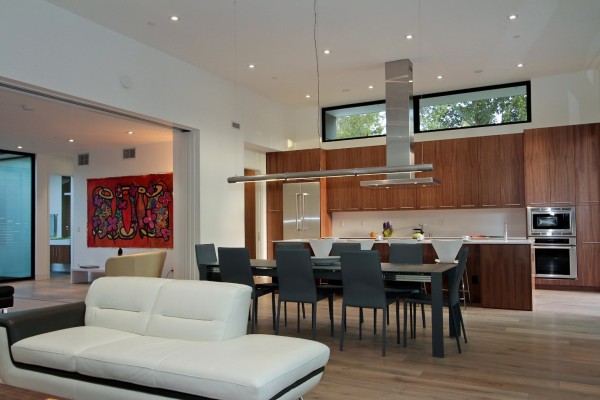These resources are from an archived version of our website. Want to see what we’ve been up to lately? Check out our new website.
Indoor air quality in new home construction
Building a new custom home? Indoor air quality should be at the top of your mind.
The average American spends 90% of their time indoors, and air contaminant levels inside the average new home are 2 to 5 times worse than the pollution levels outside.
This may come as a surprise. You’re probably aware of the toxic contaminants like lead and asbestos that have made historical headlines and reshaped building codes. But did you know that new home construction presents its own list of contaminants and pollutants to worry about?
Toxicity in new home construction
Unfortunately, most construction today is rife with chemicals and toxins that pollute our indoor air quality and negatively impact our short- and long-term health. Immediate effects of exposure to indoor pollutants include irritation of the eyes, nose and throat, headaches, dizziness, and fatigue.
According to the U.S. Environmental Protection Agency (EPA), other health effects may show up either years after exposure has occurred or only after long or repeated periods of exposure. These effects, which include some respiratory diseases, heart disease and cancer, can be severely debilitating or fatal.
The culprits
- Formaldehyde: The most common chemical in building materials, formaldehyde is found in most plywood, particle board, fiber board, and other pressed wood products used to make furniture, cabinets, shelves, and counter tops – as well other traditional construction components like resins and glues. Formaldehyde can create irritation of the throat, noes, eyes, and skin. It exacerbates asthma, and can lead to chronic respiratory symptoms, lung disease and even nasopharyngeal cancer.
- Volatile Organic Compounds (VOCs): Solvents commonly used in oil-based paints, stains, wood preservatives, carpet glue and other adhesives can release dangerous fumes that contain VOCs. Consistent exposure to VOCs has been linked to irritation of the eye, nose and throat, headaches, nausea, loss of coordination and damage to the liver, kidney, and central nervous system.
- Biological Contaminants: Poor insulation and poor ventilation in traditional construction create a breeding ground for mold, mildew, bacteria, and fungus. These biological contaminants have been proven to trigger allergic reactions and to cause asthma, influenza, shortness of breath, dizziness, lethargy, and digestive problems.
- Carbon Monoxide: Carbon Monoxide (CO) is produced by combustion sources like gas appliances, fireplaces and automobiles. Homes with attached garages are especially susceptible to CO exposure due to poor insulation, limited garage air circulation, and pressure differentials. CO presents the risk of nausea, headaches, and dizziness, with long term exposure leading to death.
The good news is that you can take steps to ensure that your new home is healthy. High-performance home building practices create a pollutant-free indoor environment, and equipped with the knowledge and the right team, you can build a home with superior indoor air quality for the health of you and your family.

High-performance for healthy air
The good news is that you can take steps to ensure that your new home is healthy. High-performance home building practices create a pollutant-free indoor environment, and equipped with the knowledge and the right team, you can build a home with superior indoor air quality. If you’re building a new custom home and want to ensure a healthy indoor environment, you should be thinking high-performance from the start.
The following high-performance home building practices maximize the quality of indoor air, and protect the health of you and your family:
- Eliminate chemicals: Ensure that there is zero formaldehyde added to any of the building materials used during construction. Ask your designer and contractor to look at all of the blues, calks, paints, carpets and flooring that go into your new home. They should review the Green Guard rating to ensure you are getting the healthiest choice for each construction element.
- Control Moisture: Proper sealing and condensation control helps control moisture and prevent mold, keeping biological contaminants at bay and protecting your health.
- Circulate: Proper air ventilation not only creates extreme energy efficiencies in your home, it ensures that the air brought inside is free of pollens and particulates, and stale air never sits in your home. Proper ventilation helps control moisture, protects against CO build up, and reduces the exposure to off-gassed chemicals from traditional construction materials.

Indoor air quality in a Clarum passive home
When Clarum builds a home, we take all of the above factors into consideration. Our team meticulously selects all of the glues, caulks, paints, and carpets that go into the passive homes we build. Specifically, we review their Green Guard rating and get the lowest we can for each element, such as low- to no-VOC paints. We pay very close attention to the home’s moisture control systems, pest management, heating, ventilating, air conditioning (HVAC) and combustion venting systems and building materials. Our attention to these details means a home that has less dust, lower pollutants, and is more comfortable and healthier for you and your family.
“The way we’re building these passive homes,” says John Suppes, “will be the way that homes are required to be built in the future. Clarum incorporates the best use of the latest technology and materials to create custom homes that are healthier and more comfortable.”
Interested in learning more about our approach to building healthy home environments? Call Clarum Homes at 650.322.7069








